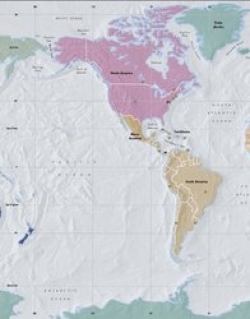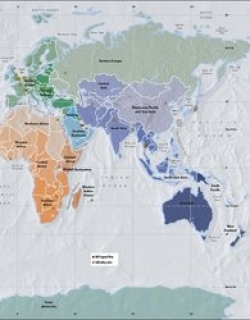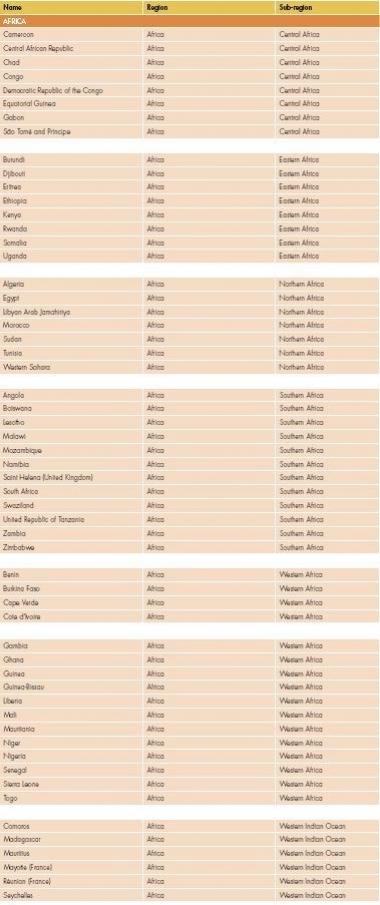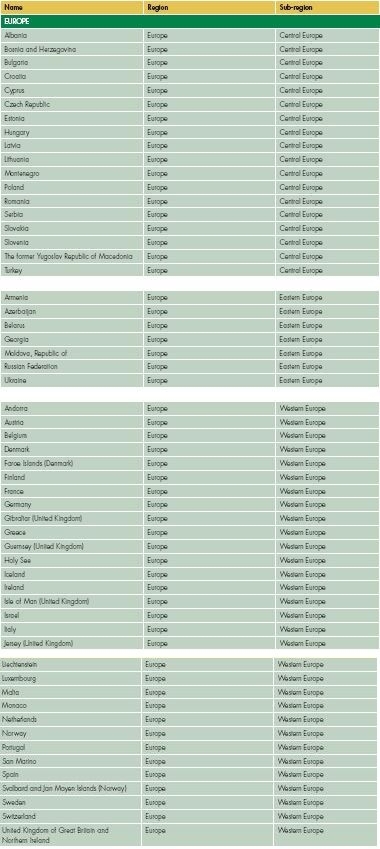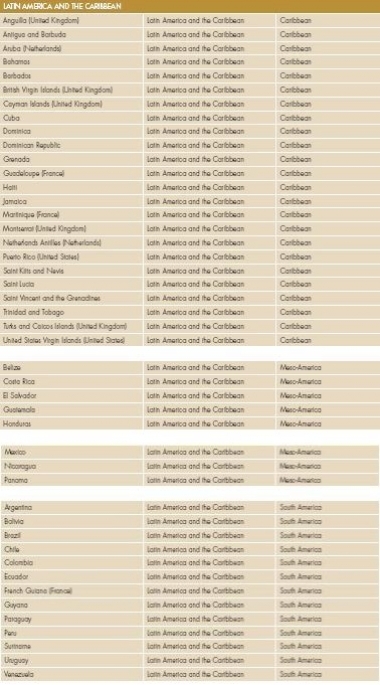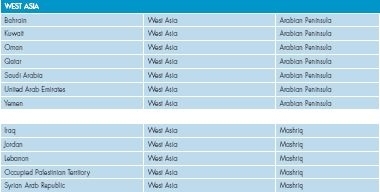Global Environment Outlook (GEO-4): Reader's Guide
The fourth Global Environment Outlook – environment for development (GEO-4) places sustainable development at the core of the assessment, particularly on issues dealing with intra- and intergenerational equity. The analyses include the need and usefulness of valuation of environmental goods and services, and the role of such services in enhancing development and human well-being, and minimizing human vulnerability to environmental change. The GEO-4 temporal baseline is 1987, the year in which the World Commission on Environment and Development (WCED) published its seminal report, Our Common Future. The Brundtland Commission was established in 1983, under UN General Assembly resolution 38/161 to look at critical environment and development challenges. It was established at a time of an unprecedented rise in pressures on the global environment, and when grave predictions about the human future were becoming commonplace.
The year 2007 is a major milestone in marking what has been achieved in the area of sustainable development and recording efforts – from local to global – to address various environmental challenges. It will be:
- Twenty years since the launch of Our Common Future, which defined sustainable development as a blueprint to address our interlinked environment and development challenges.
- Twenty years since the UNEP Governing Council adopted the “Environmental Perspective to the Year 2000 and Beyond”, to implement the major findings of the WCED and set the world on a sustainable development path.
- Fifteen years since the World Summit on Environment and Development (the Rio Earth Summit), adopted Agenda 21, providing the foundation on which to build intra- and intergenerational equity.
- Five years since the World Summit on Sustainable Development (WSSD) in 2002, which adopted the Johannesburg Plan of Implementation.
The year 2007 is also the halfway point to the implementation of some of the internationally recognized development targets, including the Millennium Development Goals (MDGs). These and other issues are analysed in the report.
The GEO-4 assessment report is the result of a structured and elaborate consultative process, which is outlined at the end of this report. GEO-4 has 10 chapters, which provide an overview of global social and economic trends, and the state-and-trends of the global and regional environments over the past two decades, as well as the human dimensions of these changes. It highlights the interlinkages as well as the challenges of environmental change and opportunities that the environment provides for human wellbeing. It provides an outlook for the future, and policy options to address present and emerging environmental issues. The following are the highlights of each chapter:
Chapter 1: Environment for Development (Global Environment Outlook (GEO-4): Reader's Guide) – examines the evolution of issues since Our Common Future popularized “sustainable development,” highlighting institutional developments and conceptual changes in thought since then, as well as the major environmental, social and economic trends, and their influence on human well-being.
Chapter 2: Atmosphere (Global Environment Outlook (GEO-4): Reader's Guide) – highlights how atmospheric issues affect human well-being and the environment. Climate change has become the greatest challenge facing humanity today. Other atmospheric issues, such as air quality and ozone layer depletion are also highlighted.
Chapter 3: Land (Global Environment Outlook (GEO-4): Reader's Guide) – addresses the land issues identified by UNEP regional groups, and highlights the pressures of human demands on the land resource as the cause of land degradation. The most dynamic elements of land-use change are the far-reaching changes in forest cover (Forest biome) and composition, cropland expansion and intensification, and urban development.
Chapter 4: Water (Global Environment Outlook (GEO-4): Reader's Guide) – reviews the pressures that are causing changes in the state of the Earth’s water environment in the context of global and regional drivers. It describes the state-and-trends in changes in the water environment, including its ecosystems and their fish stocks, emphasizing the last 20 years, and the impacts of changes on the environment and human well-being at local to global scales.
Chapter 5: Biodiversity (Global Environment Outlook (GEO-4): Reader's Guide) – highlights biodiversity as a key pillar of ecologically sustainable development, providing a synthesis of the latest information on the state-and-trends of global biodiversity. It also links trends in biodiversity to the consequences for sustainable development in a number of key areas.
Chapter 6: Sustaining a Common Future (Global Environment Outlook (GEO-4): Reader's Guide) – identifies and analyses priority environmental issues between 1987–2007 for each of the seven GEO regions: Africa, Asia and the Pacific, Europe, Latin America and the Caribbean, North America, West Asia and the Polar Regions. The chapter points out that for the first time since the GEO report series was first published in 1997, all seven regions recognize climate change as a major issue.
Chapter 7: Vulnerability of People and the Environment: Challenges and Opportunities (Global Environment Outlook (GEO-4): Reader's Guide) – identifies challenges to and opportunities for improving human well-being through analyses of the vulnerability of some environmental systems and groups in society to environmental and socioeconomic changes. The export and import of human vulnerability have grown as a result of the phenomenal global consumption (Consumption and well-being), increased poverty and environmental change.
Chapter 8: Interlinkages: Governance for Sustainability (Global Environment Outlook (GEO-4): Reader's Guide) – presents an assessment of the interlinkages within and between the biophysical components of the Earth system, environmental change, the development challenges facing human society, and the governance regimes developed to address such challenges. These elements are interlinked through significant systemic interactions and feedbacks, drivers, policy and technology synergies and trade-offs. Governance approaches that are flexible, collaborative and learning-based may be more responsive and adaptive to change, and therefore, better able to cope with the challenges of linking environment to development.
Chapter 9: The Future Today (Global Environment Outlook (GEO-4): Reader's Guide) – builds on previous chapters by presenting four scenarios to the year 2050 – Markets First, Policy First, Security First and Sustainability First – which explore how current social, economic and environmental trends may unfold, and what this means for the environment and human well-being. The scenarios examine different policy approaches and societal choices. They are presented using narrative storylines and quantitative data at both global and regional levels. The degree of many environmental changes differs over the next half-century across the scenarios as a result of differences in policy approaches and societal choices.
Chapter 10 From the Periphery to the Core of Decision Making – Options for Action (Global Environment Outlook (GEO-4): Reader's Guide) – discusses the main environmental problems highlighted in earlier chapters, and categorizes them along a continuum from problems with proven solutions to problems for which solutions are emerging. It also describes the adequacy of current policy responses, and possible barriers to more effective policy formulation and implementation. It then outlines the future policy challenges, pointing to the need for a two-track approach: extending policies that have been demonstrated to work for conventional environmental problems into regions lagging behind, and beginning to tackle the emerging environmental problems through structural reforms to social and economic systems.
FOURTH GLOBAL ENVIRONMENT OUTLOOK (GEO-4) ASSESSMENT
GEO-4 conceptual framework
The GEO-4 assessment uses the drivers-pressures-state-impacts-responses (DPSIR) framework in analysing the interaction between environmental change over the past two decades as well as in presenting the four scenarios in Chapter 9 (Global Environment Outlook (GEO-4): Reader's Guide).
The concepts of human well-being and ecosystem services are core in the analysis. However, the report broadens its assessment from focusing exclusively on ecosystems to cover the entire environment and the interaction with society. The framework attempts to reflect the key components of the complex and multidimensional, spatial and temporal chain of cause-and-effect that characterizes the interactions between society and the environment. The GEO-4 framework is generic and flexible, and recognizes that a specific thematic and geographic focus may require a specific and customized framework.
The GEO-4 conceptual framework (Figure 1), therefore, contributes to society’s enhanced understanding of the links between the environment and development, human wellbeing and vulnerability to environmental change. The framework places, together with the environment, the social issues and economic sectors in the ‘impacts’ category rather than just exclusively in the ‘drivers’ or ‘pressures’ categories (Figure 1). The characteristics of the components of the GEO-4 analytical framework are explained below.
Drivers
Drivers are sometimes referred to as indirect or underlying drivers or driving forces. They refer to fundamental processes in society, which drive activities with a direct impact on the environment. Key drivers include: demographics; consumption and production patterns; scientific and technological innovation; economic demand, markets and trade; distribution patterns; institutional and social-political frameworks and value systems. The characteristics and importance of each driver differ substantially from one region to another, within regions and within and between nations. For example, in the area of population dynamics, most developing countries are still facing population growth while developed countries are faced with a stagnant and ageing population. The resource demand of people influence environmental change.
Pressures
Key pressures include: emissions of substances which may take the form of pollutants or waste; external inputs such as fertilizers, chemicals and irrigation; land use; resource extraction; and modification and movement of organisms. Human interventions may be directed towards causing a desired environmental change such as land use, or they may be intentional or unintentional by-products of other human activities, for example, pollution. The characteristics and importance of each pressure may vary from one region to another, but is often a combination of pressures that lead to environmental change. For example, climate change is a result of emissions of different greenhouse gases, deforestation and land-use practices. Furthermore, the ability to create and transfer environmental pressures onto the environment of other societies varies from one region to another. Affluent societies with high levels of production, consumption and trade tend to contribute more towards global and transboundary environmental pressures than the less affluent societies which interact in more direct fashion with the environment in which they live.
State-and-trends
Environmental state also includes trends, which often refers to environmental change. This change may be natural, human-induced or both. Examples of natural processes include solar radiation, extreme natural events, pollination, and erosion. Key forms of human induced environmental change include climate change, desertification and land degradation, biodiversity loss, and air (Air pollution) and water pollution, for example.
Different forms of natural or human-induced changes interact. One form of change, for example, climate change, will inevitably lead to ecosystem change, which may result in desertification and/or biodiversity loss. Different forms of environmental change can reinforce or neutralize each other. For example, a temperature increase due to climate change can, in Europe, partly be offset by changes in ocean currents triggered by climate change. The complexity of the physical, chemical and biological systems constituting the environment makes it hard to predict environmental change, especially when it is subject to multiple pressures. The state of the environment and its resilience to change varies greatly within and among regions due to different climatic and ecological conditions.
Impacts
The environment is directly or indirectly affected by the social and economic sectors, contributing to change (either negative or positive) in human well-being and in the capacity/ability to cope with environmental changes. Impacts, be they on human well-being, the social and economic sectors or environmental services, are highly dependent on the characteristics of the drivers and, therefore, vary markedly between developing and developed regions.
Responses
Responses address issues of vulnerability of both people and the environment, and provide opportunities for reducing human vulnerability and enhancing human well-being. Responses take place at various levels: for example, environmental laws and institutions at the national level, and multilateral environmental agreements and institutions at the regional and global levels. The capacity to mitigate and/or adapt to environmental change differs among and within regions, and capacity building is, therefore, a major and overarching component of the response components.
The GEO-4 framework has been used in the analyses of issues in all the 10 chapters, both explicitly and implicitly. Its utility is in integrating the analyses to better reflect the cause-and-effect, and ultimately society’s response in addressing the environmental challenges it faces.
A variation of Figure 1 is presented in Chapter 8 (Global Environment Outlook (GEO-4): Reader's Guide) as Figure 8.2 to better highlight the dual roles of economic sectors such as agriculture, forestry, fisheries and tourism – in contributing to development and human well-being, and also in exerting pressure on the environment and influencing environmental change, and in some cases, to human vulnerability to such change.
GEO-4 Regions
|
|

